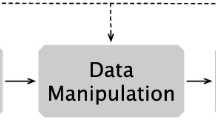Abstract
Multivariate volume data sets usually have complex interactions between fields, and features from different fields, such as segmented regions and isosurfaces, can be associated together to intuitively reveal the correlation and difference between fields. In this paper, we present a visual analytic approach for interactive feature exploration. A graph-based representation, called FeatureNet, is designed to provide a full picture of major features extracted from each field. FeatureNet visually summarizes both the nesting and association relationships of major features in each variable, and serves as a navigation tool to guide data exploration. Case studies with three simulation data sets demonstrate the effectiveness and usefulness of FeatureNet, and it can help users better understand and inspect the nesting and correlation relationships between fields.
Graphical Abstract









Similar content being viewed by others
References
Acharya, A., Natarajan, V.: A parallel and memory efficient algorithm for constructing the contour tree. In: 2015 IEEE PacificVis 2015, Hangzhou, China, April 14-17, 2015, pp. 271–278 (2015)
Balabanian JP, Viola I, Gröller E (2010) Interactive illustrative visualization of hierarchical volume data. In: Proceedings of Graphics Interface 2010, GI ’10, pp 137–144. Canadian Information Processing Society
Biswas A, Dutta S, Shen HW, Woodring J (2013) An information-aware framework for exploring multivariate data sets. IEEE TVCG 19(12):2683–2692
Carr H, Duke D (2013) Joint contour nets: computation and properties. In: PacificVis 2013, IEEE , pp 161–168
Carr H, Snoeyink J, Axen U (2003) Computing contour trees in all dimensions. Comput Geom 24(2):75–94
Carr H, Snoeyink J, van de Panne M (2010) Flexible isosurfaces: simplifying and displaying scalar topology using the contour tree. Comput Geom Theory Appl 43(1):42–58
Conte D, Foggia P, Sansone C, Vento M (2004) Thirty years of graph matching in pattern recognition. Int J Pattern Recognit Artif Intell 18:265–298
Duke D, Carr H, Knoll A, Schunck N, Nam HA, Staszczak A (2012) Visualizing nuclear scission through a multifield extension of topological analysis. IEEE TVCG 18(12):2033–2040
Fruchterman TMJ, Reingold EM (1991) Graph drawing by force-directed placement. Softw Pract Exper 21(11):1129–1164
Geng Z, Duke DJ, Carr H, Chattopadhyay A (2014) Visual analysis of hurricane data using joint contour net. In: TPCG, pp 33–40
Gleicher M, Albers D, Walker R, Jusufi I, Hansen CD, Roberts JC (2011) Visual comparison for information visualization. Inf Vis 10(4):289–309
Gosink L, Anderson J, Bethel W, Joy K (2007) Variable interactions in query-driven visualization. IEEE TVCG 13(6):1400–1407
Gu Y, Wang C (2011) Transgraph: hierarchical exploration of transition relationships in time-varying volumetric data. IEEE TVCG 17(12):2015–2024
Haidacher M, Bruckner S, Groller E (2011) Volume analysis using multimodal surface similarity. IEEE TVCG 17(12):1969–1978
Haller G (2005) An objective definition of a vortex. J Fluid Mech 525:1–26
Janicke H, Wiebel A, Scheuermann G, Kollmann W (2007) Multifield visualization using local statistical complexity. IEEE TVCG 13(6):1384–1391
Kamada T, Kawai S (1989) An algorithm for drawing general undirected graphs. Inf Process Lett 31(1):7–15
Liu X, Shen HW (2016) Association analysis for visual exploration of multivariate scientific data sets. IEEE TVCG 22(1):955–964
Lukasczyk J, Weber G, Maciejewski R, Garth C, Leitte H (2017) Nested tracking graphs. Comput Graph Forum 36(3):12–22
Nagaraj S, Natarajan V (2011) Relation-aware isosurface extraction in multifield data. IEEE TVCG 17(2):182–191
Nagaraj S, Natarajan V, Nanjundiah RS (2011) A gradient-based comparison measure for visual analysis of multifield data. Comput Graph Forum 30(3):1101–1110
Saikia H, Seidel HP, Weinkauf T (2014) Extended branch decomposition graphs: structural comparison of scalar data. Comput Graph Forum (Proc. EuroVis) 33(3):41–50
Saikia H, Seidel HP, Weinkauf T (2015) Fast similarity search in scalar fields using merging histograms. In: TopoInVis 2015, May 20-22, pp 1–14
Saikia H, Weinkauf T (2017) Global feature tracking and similarity estimation in time-dependent scalar fields. Comput Graph Forum 36(3):1–11
Sauber N, Theisel H, Seidel HP (2006) Multifield-graphs: an approach to visualizing correlations in multifield scalar data. IEEE TVCG 12(5):917–924
Schneider D, Heine C, Carr H, Scheuermann G (2013) Interactive comparison of multifield scalar data based on largest contours. Comput Aided Geom Des 30(6):521–528
Schneider D, Wiebel A, Carr H, Hlawitschka M, Scheuermann G (2008) Interactive comparison of scalar fields based on largest contours with applications to flow visualization. IEEE TVCG 14(6):1475–1482
Sukharev J, Wang C, Ma KL, Wittenberg AT (2009) Correlation study of time-varying multivariate climate data sets. In: Visualization Symposium, 2009. PacificVis’ 09, IEEE, pp 161–168
Thomas DM, Natarajan V (2014) Multiscale symmetry detection in scalar fields by clustering contours. IEEE TVCG 20(12):2427–2436
Wang C, Shen HW (2006) Lod map—a visual interface for navigating multiresolution volume visualization. IEEE TVCG 12(5), pp 1029–1036
Wang C, Shen HW (2005) Hierarchical navigation interface: leveraging multiple coordinated views for level-of-detail multiresolution volume rendering of large scientific data sets. In: Ninth International Conference on Information Visualisation (IV’05), pp 259–267
Wang C, Tao J (2017) Graphs in scientific visualization: a survey. Comput Graph Forum 36(1):263–287
Wang C, Yu H, Grout RW, Ma KL, Chen JH (2011) Analyzing information transfer in time-varying multivariate data. In: 2011 IEEE PacificVis, pp 99–106
Weber G, Bremer PT, Pascucci V (2007a) Topological landscapes: a terrain metaphor for scientific data. IEEE TVCG 13(6):1416–1423
Weber GH, Dillard SE, Carr H, Pascucci V, Hamann B (2007b) Topology-controlled volume rendering. IEEE TVCG 13(2):330–341
Widanagamaachchi, W, Christensen C, Pascucci V, Bremer PT (2012) Interactive exploration of large-scale time-varying data using dynamic tracking graphs. In: IEEE Symposium on LDAV, 2012 , pp 9–17
Yantis S (1992) Multielement visual tracking: attention and perceptual organization. Cogn Psychol 24(3):295–340
Acknowledgements
The authors would like to thank the anonymous reviewers for their valuable comments. This work was supported by the National Key Research & Development Program of China (2017YFB0202203), National Natural Science Foundation of China (61472354 and 61672452), NSFC-Guangdong Joint Fund (U1611263), and the Fundamental Research Funds for the Central Universities.
Author information
Authors and Affiliations
Corresponding authors
Rights and permissions
About this article
Cite this article
Wang, Q., Tao, Y. & Lin, H. FeatureNet: automatic visual summarization of major features in multivariate volume data. J Vis 21, 443–455 (2018). https://doi.org/10.1007/s12650-017-0459-x
Received:
Revised:
Accepted:
Published:
Issue Date:
DOI: https://doi.org/10.1007/s12650-017-0459-x




